
Top 10 VMware Alternatives: Complete Virtualization Guide for All Business Sizes
Is VMware Still the Right Choice for Your Virtualization Needs?
If you’ve been relying on VMware for your virtualization needs, you’re not alone. It’s been the go-to for enterprise IT for years, holding about 44% of the market. But things are shifting in 2025, and you might be feeling the pinch.
Broadcom’s acquisition of VMware in late 2023 has led to massive price hikes (some as high as 2–3x, or even 10x in cases like AT&T’s). New licensing rules, like 72-core minimums for vSphere, are also pushing many to look elsewhere. In fact, according to Gartner’s Peer Community, 74% of IT leaders are currently exploring VMware alternatives. If you’re rethinking your virtualization strategy, you’re in the right place.
At HorizonIQ, we work closely with organizations navigating this shift, especially those prioritizing predictability, compliance, and cost control in their infrastructure stack. I’ll walk you through why so many are moving away from VMware, break down the top alternatives for 2025, and give you tailored recommendations based on your company’s size and infrastructure.
Whether you’re running a small IT shop or managing a global enterprise, you’ll get clear comparisons, real-world use cases, and practical advice to help you pick the right VMware alternative.
What Is VMware?
Since 1999, VMware has been a leading provider of virtualization and cloud computing software. At its core, VMware allows you to run multiple virtual machines (VMs) on a single physical server, maximizing hardware efficiency and flexibility.
Each VM operates with its own operating system and applications, just like a physical server. The most common components used in enterprise environments include:
Platform |
Description |
ESXi |
A Type-1 hypervisor installed directly on hardware to manage virtual machines. |
vSphere |
VMware’s suite of tools, including vCenter Server, for managing ESXi hosts and VMs. |
vMotion |
Enables live migration of running VMs between physical servers with no downtime. |
High Availability (HA) |
Automatically restarts VMs on other hosts in case of a hardware failure. |
VMware Cloud |
Offers hybrid and multi-cloud capabilities, such as VMware Cloud on AWS. |
Tanzu |
VMware’s Kubernetes platform for containerized application deployment. |
For years, VMware has been considered the gold standard in enterprise virtualization due to its rich feature set, robust performance, and reliability.
However, with dramatic price hikes and vendor lock-in concerns following the Broadcom Acquisition, many have begun to express their concerns.
Why Are Companies Seeking VMware Alternatives?
Organizations are starting to reassess long-standing tools like VMware, not necessarily because the technology isn’t strong, but because the environment around it has changed. You may have leaned on VMware’s vSphere platform, powered by the ESXi hypervisor and vCenter management, for its rock-solid features like live migration (vMotion), high availability, and robust VM management.
Its hybrid-cloud options, like VMware Cloud on AWS, and container support through Tanzu keep have attracted privacy-first organizations for years. Here are some of the top reasons customers are considering VMware alternatives:
Skyrocketing Costs
As previously mentioned, since Broadcom took over, VMware’s licensing fees have spiked. Many smaller businesses are also being hit hard by the loss of affordable bundles like vSphere Essentials Plus.
Feature Overload
If you don’t need advanced tools like Distributed Resource Scheduler (DRS), you’re likely overpaying for bells and whistles you don’t use. Adding to the frustration, Broadcom’s EMEA CTO recently brushed off customer complaints about the VMware price hikes by claiming that customers simply aren’t using it properly to get VMware Cloud Foundation’s full advantages.
Cloud and Hybrid Needs
As you adopt hybrid cloud or containerized setups, you’ll need platforms that play nicely with tools like Kubernetes or public clouds. Something VMware struggles with without expensive add-ons like Tanzu.
Complexity
VMware’s feature-packed ecosystem demands specialized skills and hefty hardware, which can overwhelm smaller teams or inflate costs.
Vendor Lock-In
VMware’s proprietary setup can trap you, making it tough to integrate with other platforms or migrate away.
Niche Workloads
If you’re running GPU-heavy virtual desktop infrastructure (VDI), many are finding better performance on specialized platforms that offer optimized GPU virtualization and higher VDI density out of the box.
How Do the Best VMware Alternatives Compare?
| Alternative | Key Features | Scalability & Performance | Licensing/Cost Model | Support & Integration |
|---|---|---|---|---|
Hyper-V |
Type-1 hypervisor, Windows integration, Shielded VMs | Enterprise-grade; supports large VMs (48TB RAM) | Included with Windows Server | Microsoft support, integrates with Azure, AD, System Center |
Proxmox VE |
Open-source, KVM + LXC, web UI, clustering, Ceph | Scales from labs to clusters; near bare-metal KVM performance | Free; paid support optional | Community and enterprise support; integrates with Ceph, NFS, APIs |
Nutanix AHV |
Type-1 HCI hypervisor, Prism UI, one-click operations | Scalable via node expansion; ideal for large enterprise setups | Included with Nutanix HCI | Enterprise support; integrates with Prism, AWS/Azure |
XCP-ng |
Open-source Xen-based, managed via Xen Orchestra | Multi-host pools; solid Xen performance | Free; optional Vates support | Xen tools, VMware migration tools; commercial and community support |
Red Hat OpenShift Virtualization |
KVM-based, OpenShift console, Ansible automation | Scales to hundreds of VMs; runs Linux + Windows alongside containers | Subscription-based, cost-effective for Linux shops | Red Hat support, integrates with RHEL, Ansible, OpenShift |
OpenStack |
Open-source IaaS, modular services (Nova, Neutron, Cinder, etc.) | Highly scalable; supports multi-region clouds and massive deployments | Free; staffing and support costs | Large community; vendor support available (e.g. Red Hat, Canonical) |
Harvester |
Open-source HCI platform, KubeVirt, Rancher UI, VM + container support | Small to medium clusters; scales via Rancher-managed clusters | Free; community-supported | Integrates with Rancher, Kubernetes, Longhorn; community support |
XenServer |
VDI-optimized, GPU support, integrates with Citrix VDI | Supports 960 logical processors/host; excels in VDI | Free trial, paid for premium features | Citrix support, smaller ecosystem, Windows-only XenCenter |
SUSE Linux Enterprise |
KVM/Xen support, integrates with Rancher, Secure Boot | Scales on modern hardware; ideal for SAP and Linux-heavy workloads | Subscription-based | SUSE support, integrates with Rancher, standard virtualization protocols |
Oracle VirtualBox |
Free Type-2 hypervisor, GUI, snapshot/clones | Limited scalability; best for dev/test | Free; optional commercial Extension Pack | Community support, supports OVF/OVA; limited enterprise tools |
What Are the Top VMware Alternatives?
The best VMware alternative will come down to your use case and budget, but we recommend considering the following:
1. Microsoft Hyper-V
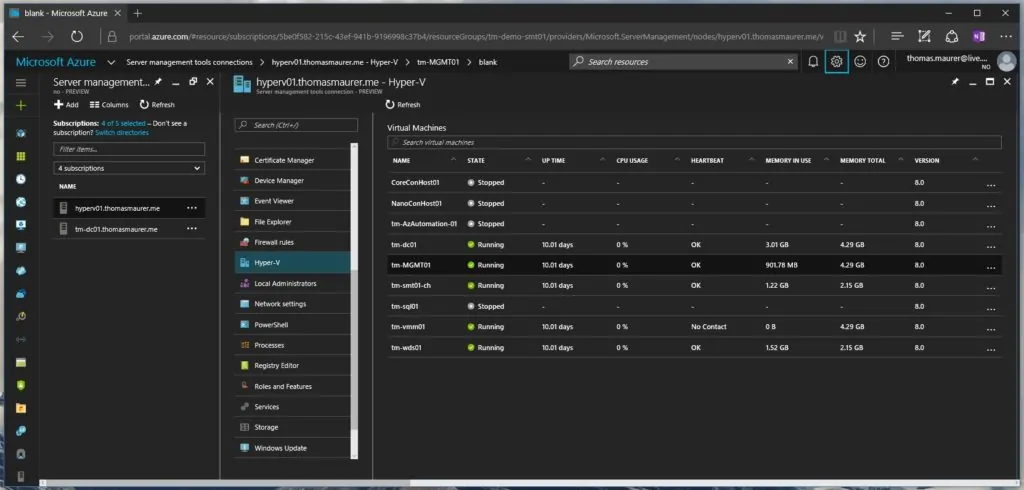
If you’re already invested in Windows, Microsoft Hyper-V is a no-brainer. Built into Windows Server, this Type-1 hypervisor supports both Windows and Linux VMs, with features like live migration, high availability, and Shielded VMs for extra security.
It integrates tightly with Active Directory and PowerShell, making it especially attractive for IT teams already managing a Microsoft environment. Hyper-V Replica offers built-in disaster recovery, while clustering and failover support provide strong resiliency for production workloads.
It’s also a natural fit for hybrid setups, pairing well with Azure for cloud bursting, backup, or DR. As a VMware alternative, it stands out for organizations looking to consolidate costs and avoid new licensing complexities without sacrificing core virtualization capabilities.
What You Get
- Seamless integration with Microsoft tools like Active Directory, System Center, and PowerShell.
- Virtual networking and storage that rival VMware’s capabilities.
- Strong hybrid cloud integration with Azure.
Cost
It’s included with Windows Server licenses. Standard edition gives you 2 VMs per host, Datacenter edition offers unlimited. No separate hypervisor license means big savings if you’re a Windows shop.
Pros
- Cost-effective if you’re already using Windows Server.
- Familiar for Windows admins.
- Strong Azure integration for hybrid cloud.
- Robust security features.
Cons
- Weaker support for non-Windows OSes.
- Smaller third-party ecosystem than VMware.
- Some advanced networking features don’t match VMware’s NSX.
Example Use Case
Imagine you’re a mid-sized retailer with 200 employees, running Windows Server and Azure. Hyper-V lets you virtualize your ERP and inventory systems, saving on VMware licenses while using Azure for disaster recovery.
Best For
Windows-centric SMBs and enterprises eyeing hybrid cloud setups.
How HorizonIQ Can Help
HorizonIQ has years of experience managing Windows infrastructure. While we do not offer a managed Hyper-V solution, our team can set up the underlying infrastructure, install Windows, and make any ongoing patches. We have helped a number of companies use this model to successfully migrate from VMware to Hyper-V.
2. Proxmox VE

If you want flexibility without the price tag, Proxmox VE is worth a look. This open-source platform, built on Debian Linux, combines KVM VMs and LXC containers in an easy-to-use web interface.
It includes enterprise-grade features like live migration, high availability, backup scheduling, and built-in clustering, without separate licensing costs. Storage is equally flexible, with native support for ZFS, Ceph, and directory-based storage.
You can manage everything from a single pane of glass, and the REST API makes automation straightforward. As a VMware alternative, Proxmox appeals to teams that want full control over their stack, a strong open-source community, and the freedom to run mixed workloads with minimal overhead.
What You Get
- Intuitive web UI for managing VMs and containers.
- Clustering, live migration, and high availability.
- Built-in Ceph storage and backup scheduling.
Cost
It’s free, with optional support subscriptions (a few hundred bucks per socket annually), saving you up to millions compared to VMware.
Pros
- No licensing fees, all features included.
- User-friendly web interface.
- Supports both VMs and containers.
- Active community with frequent updates.
Cons
- Community support unless you pay for a subscription.
- Less polished UI than VMware.
- Smaller third-party ecosystem.
- Advanced features need Linux expertise.
Example Use Case
If you’re running IT for a university, Proxmox lets you manage Windows VMs for administrative apps and Linux containers for research microservices, slashing licensing costs.
Best For
SMBs, labs, and mixed-workload environments with Linux know-how.
How HorizonIQ Can Help
HorizonIQ was the first US infrastructure provider to offer a managed Proxmox private cloud solution. If you think Proxmox will work for your business but are worried that your team does not have the skills to manage the environment, this is the solution for you. HorizonIQ’s team does the heavy lifting and manages the setup and ongoing operation of the Proxmox cluster so your team can focus on more important tasks.
Looking to migrate without overlap costs?
Migration shouldn’t drain your budget. With HorizonIQ’s 2 Months Free, you can move workloads, skip the overlap bills, and gain extra time to switch providers without double paying.
Get 2 Months Free3. Nutanix AHV
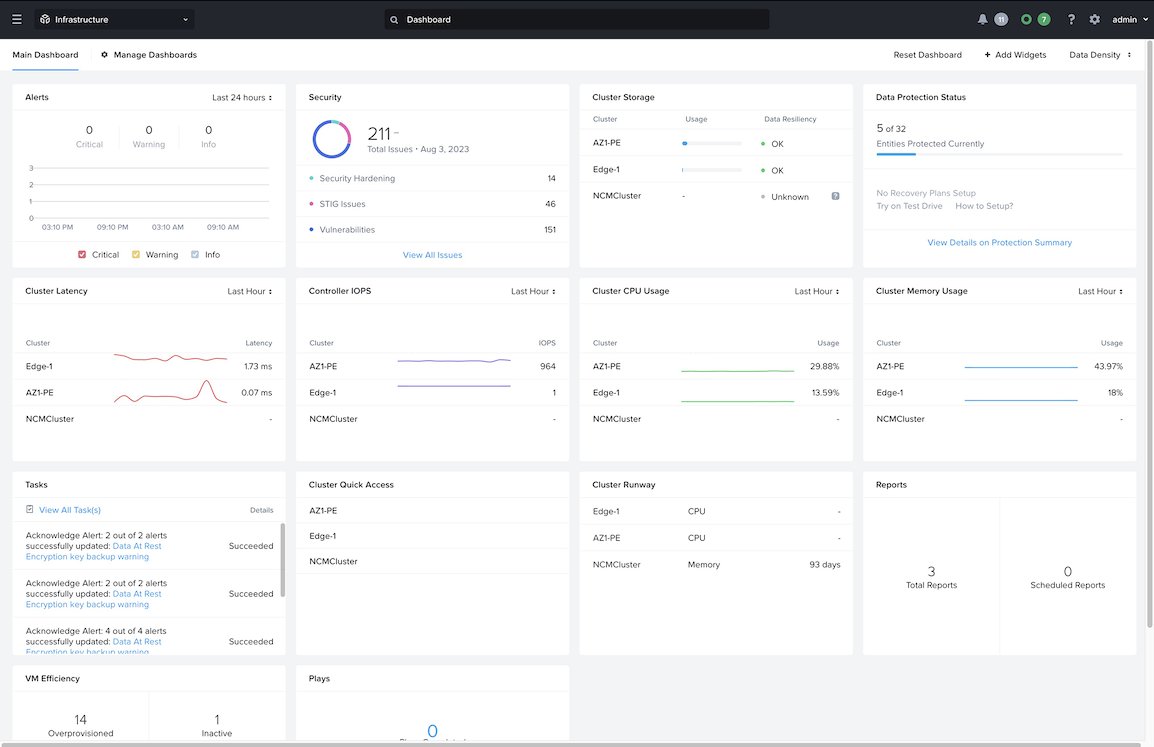
If you’re looking to streamline infrastructure, Nutanix’s Acropolis Hypervisor (AHV) is a Type-1 hypervisor built into its hyper-converged infrastructure (HCI) platform, managed via the Prism UI. AHV is tightly integrated with Nutanix’s storage, networking, and virtualization stack, enabling simplified management and automation from a single console.
It supports features like live migration, high availability, and integrated backup, while eliminating the need for separate hypervisor licensing. Prism Central provides policy-based management, capacity planning, and performance monitoring, making it appealing to IT teams looking to consolidate operations.
As a VMware alternative, AHV is best suited for organizations adopting HCI that want an all-in-one solution to reduce complexity and total cost of ownership.
What You Get
- One-click operations for upgrades and management.
- High availability, live migration, and integrated storage.
- Microsegmentation and hybrid cloud support.
Cost
Included with Nutanix HCI subscriptions, so no separate hypervisor fees, potentially lowering your total cost.
Pros
- Simplified infrastructure management.
- High performance and scalability.
- No separate hypervisor cost.
- Cloud-like management experience.
Cons
- High initial hardware investment.
- Potential Nutanix ecosystem lock-in.
- Fewer advanced features than VMware.
- Requires training for optimal use.
Example Use Case
If you’re a financial services firm replacing aging VMware and SAN setups, Nutanix AHV consolidates compute and storage and cuts down on VMware licensing costs.
Best For
Enterprises that are looking for HCI and simplified management, especially during hardware refreshes.
How HorizonIQ Can Help
HorizonIQ can work with you to potentially source Nutanix-compliant hardware. If that’s feasible, your team would be responsible for licensing and installing Nutanix.
4. XCP-ng
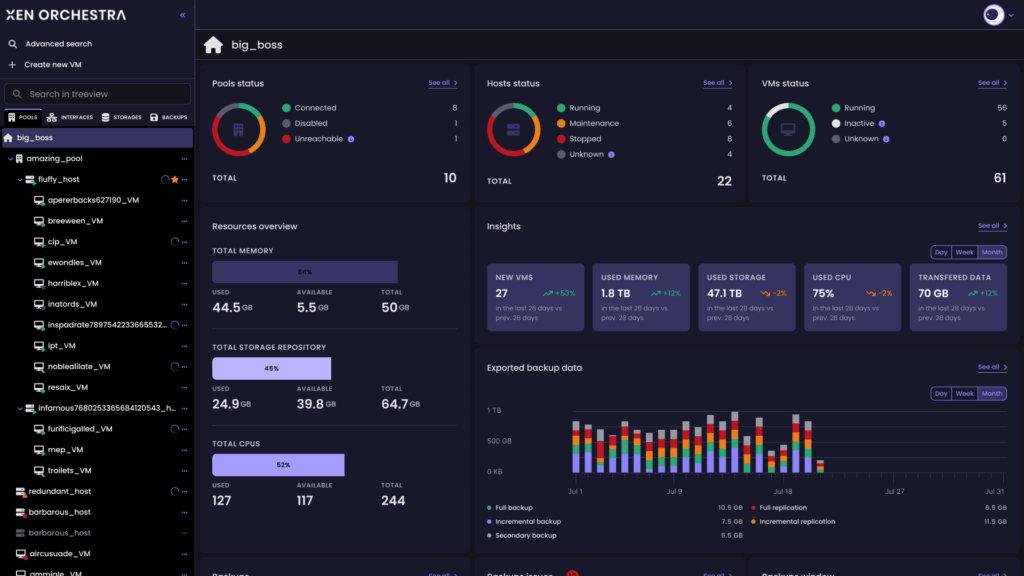
If you love VMware’s management style but hate the cost, XCP-ng is a free, Xen-based fork of XenServer.
It pairs with Xen Orchestra for a vSphere-like management experience. You get features like live migration, snapshots, high availability, and built-in backup and restore, which are all accessible through a clean, browser-based UI. XCP-ng supports both Windows and Linux VMs, and its active open-source community helps with regular updates and plugin development.
It’s also API-friendly, making it a good fit for teams looking to automate provisioning and lifecycle management. As a VMware alternative, it offers familiar functionality without vendor lock-in, making it appealing for organizations prioritizing transparency and long-term cost savings.
What You Get
- Live migration (XenMotion), high availability, and snapshots.
- GPU virtualization support.
- Xen Orchestra’s polished, vCenter-like web UI.
Cost
Free, with optional Vates support, making it a fraction of VMware’s cost.
Pros
- Free and open-source.
- Familiar management for VMware admins.
- Robust Xen hypervisor.
- Active community development.
Cons
- Less mindshare than KVM or Hyper-V.
- Fewer third-party integrations.
- Windows VM tools aren’t as seamless.
- Some Xen-specific learning required.
Example Use Case
If you’re a managed service provider, XCP-ng lets you host client workloads with Xen’s multi-tenant isolation and Xen Orchestra’s intuitive management, replacing VMware clusters.
Best For
Mid-sized enterprises and MSPs that want a VMware-like experience without the price tag.
How HorizonIQ Can Help
HorizonIQ can set up the necessary infrastructure for you to run XCP-ng. From here, your team would install the XCP-ng image and get it going.
5. Red Hat OpenShift Virtualization
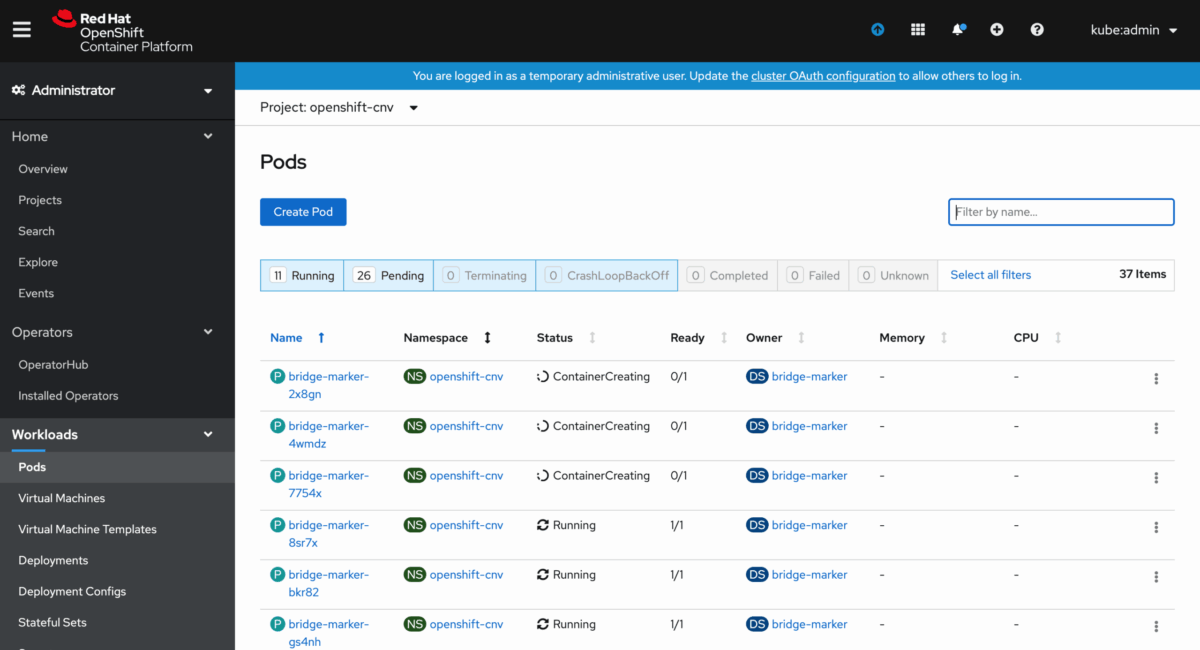
If you’re modernizing Linux workloads, OpenShift Virtualization extends your Red Hat stack with container-native VMs. It builds on OpenShift and KVM, with automation powered by Ansible and RHEL integration.
You can run VMs alongside containers on the same Kubernetes platform, making it easier to manage hybrid workloads and transition legacy apps. Built-in features include live migration, high availability, and persistent storage via OpenShift Data Foundation.
Developers can manage VMs using the same GitOps and CI/CD workflows they use for containers, streamlining operations across teams. As a VMware alternative, it’s a strong choice for Red Hat environments looking to unify VM and container management under a single, cloud-native control plane.
What You Get
- Run virtual machines alongside containers.
- Live migration, snapshots, and persistent storage.
- Unified management through the OpenShift web console.
Cost
Subscription-based, often more affordable than VMware, especially if you already use OpenShift or Red Hat Enterprise Linux.
Pros
- Integrated with RHEL, OpenShift, and Ansible.
- Ideal for hybrid container and VM environments.
- Strong security and Red Hat support.
- Future-ready Kubernetes-native architecture.
Cons
- Requires OpenShift knowledge to manage.
- More complex than traditional hypervisors.
- Limited to KVM-based VMs.
- Still maturing compared to legacy virtualization tools.
Example Use Case
A fintech company runs OpenShift for cloud-native apps and adds OpenShift Virtualization to support legacy VMs without expanding infrastructure.
Best For
Enterprises running Linux and containers who are looking to consolidate VMs into a Kubernetes-native platform.
How HorizonIQ Can Help
HorizonIQ has years of experience managing Red Hat infrastructure. While we do not offer a managed OpenShift solution, our team can set up the underlying infrastructure, install your desired version of Red Hat, and make any ongoing patches.
6. OpenStack
If vendor lock-in and licensing costs are top concerns, OpenStack offers a compelling alternative. This open-source cloud platform, governed by the Open Infrastructure Foundation, is vendor-agnostic and designed to run on standard hardware.
Built to support hyper-converged architectures, OpenStack combines compute, networking, and storage (often with Ceph) into a unified solution. As a VMware alternative, OpenStack offers full control over your private cloud infrastructure, free from proprietary constraints, and is backed by a global community with zero licensing fees.
What You Get
- Open-source cloud infrastructure platform (Apache-licensed).
- Vendor-agnostic deployment on standard hardware.
- Hyper-converged architecture with integrated compute, networking, and storage.
- Native Ceph support for scalable storage.
- Active global support community.
- No vendor lock-in or proprietary dependencies.
Cost
OpenStack itself is free (no licensing fees, no per-core or per-socket pricing). Costs center around your hardware, staffing, and support resources. Compared to VMware’s subscription-based model, OpenStack can drastically reduce software-related expenses.
Pros
- No software licensing costs.
- Total control over infrastructure.
- Avoids vendor lock-in.
- Large, active open-source community.
- Supports scalable private cloud deployments.
Cons
- Complex to deploy and manage without in-house expertise.
- Community-based support unless working with a managed provider.
- Frequent updates can require careful version management.
- May require external consultants or additional staff.
Example Use Case
Enterprises like Target and GE Healthcare use OpenStack to avoid long-term vendor commitments while controlling cloud costs. By deploying OpenStack on standard servers, IT teams can build private cloud environments without licensing fees and scale workloads flexibly using Ceph for storage.
Best For
Enterprises, large organizations, and teams prioritizing vendor neutrality, cost control, and infrastructure ownership.
How HorizonIQ Can Help
HorizonIQ can provision the underlying hardware and networking needed to deploy OpenStack. From there, your team can install and configure Harvester to manage VMs and containers in your environment.
7. Harvester

If simplicity and Kubernetes-native management are priorities, Harvester offers a modern, open-source alternative to VMware. Built by SUSE, Harvester is a lightweight hyperconverged infrastructure (HCI) platform that combines virtualization and Kubernetes orchestration into a unified solution.
Using KVM as its underlying hypervisor and Rancher for cluster management, Harvester allows IT teams to manage both virtual machines and containers through a single, web-based interface. As a VMware alternative, Harvester eliminates hypervisor licensing costs and simplifies virtualization with built-in storage, networking, and monitoring.
What You Get
- Open-source HCI platform (Apache-licensed).
- Integrated KVM-based hypervisor.
- Kubernetes-native VM management via Rancher UI.
- Built-in Longhorn block storage and integrated virtual networking.
- Lightweight deployment on standard x86 hardware.
- No proprietary software dependencies.
- SUSE support available (optional).
Cost
Harvester is fully open-source with no licensing fees. You only pay for hardware and optional SUSE support. Compared to VMware’s subscription-based pricing, Harvester offers significant savings by eliminating hypervisor and management licensing.
Pros
- No hypervisor licensing costs.
- Simple, unified VM and container management.
- Kubernetes-native architecture (ideal for modern workloads).
- Lightweight, fast deployment.
- Integrated storage and networking reduce third-party dependencies.
- Backed by SUSE with optional enterprise support.
Cons
- Less mature than OpenStack or VMware in large-scale enterprise deployments.
- Smaller ecosystem and community.
- Limited advanced networking features compared to NSX.
- Focused more on edge, SMB, and modern workloads than legacy enterprise apps.
Example Use Case
SMBs and DevOps teams use Harvester to simplify virtualization without sacrificing flexibility. For example, a software company might deploy Harvester across 5–10 servers, managing VMs for backend services while simultaneously orchestrating container workloads via Rancher.
Best For
- SMBs, SaaS providers, and DevOps teams seeking a Kubernetes-native virtualization platform.
- Organizations prioritizing simple HCI deployment, modern workload management, and reduced licensing costs.
How HorizonIQ Can Help
HorizonIQ can provision the underlying hardware and networking needed to deploy Harvester. From there, your team can install and configure Harvester to manage VMs and containers in your environment. If needed, HorizonIQ can assist with initial setup guidance to help accelerate your deployment.
8. XenServer
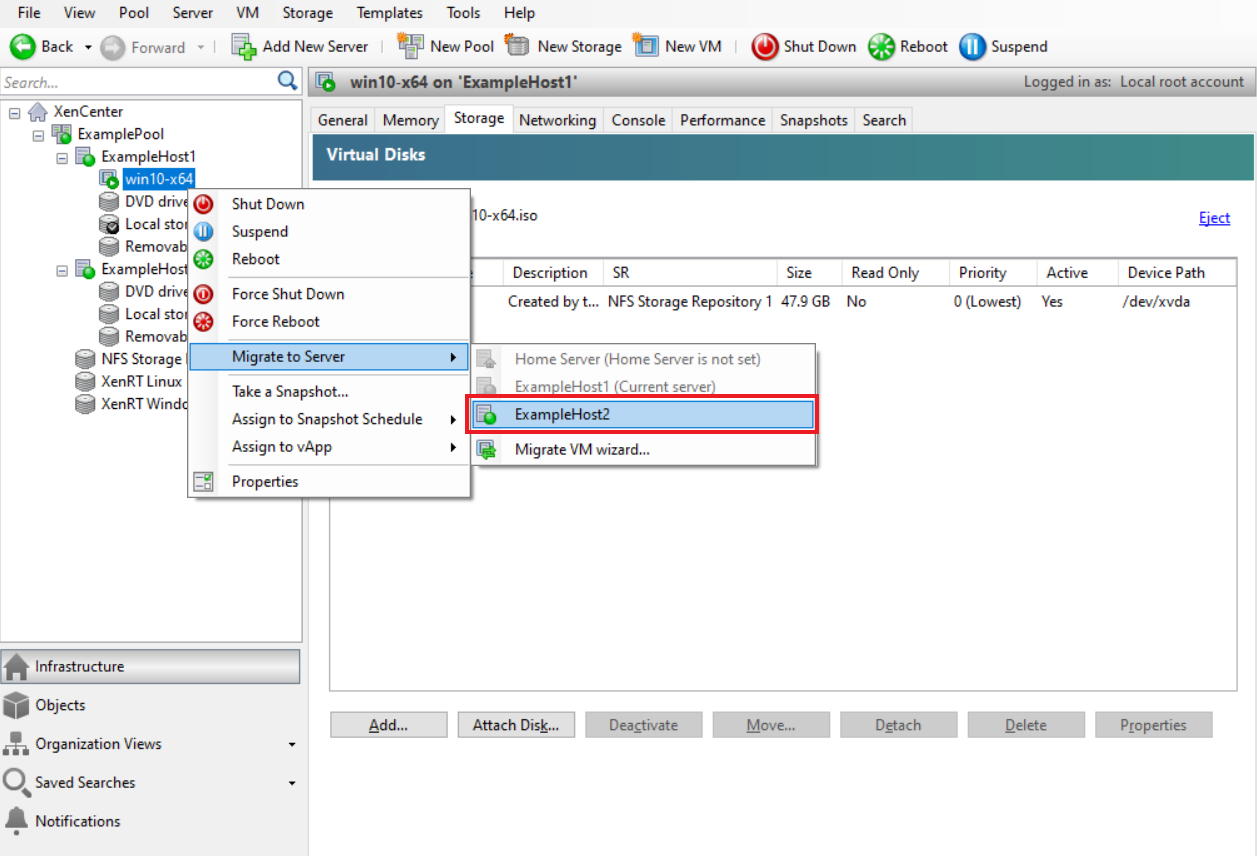
If virtual desktops are your priority, XenServer 8.4 (formerly known as Citrix Hypervisor) is a Xen-based Type-1 hypervisor purpose-built for VDI and GPU-intensive workloads. It integrates tightly with Citrix Virtual Apps and Desktops, making it a strong fit for Citrix-centered environments.
Features like GPU passthrough, high availability, and live migration are built in, along with security tools like Direct Inspect APIs for introspection. XenServer is optimized for scalability, supporting large hosts and dense VM deployments—ideal for desktop virtualization at scale.
As a VMware alternative, it stands out in environments that prioritize graphics performance and Citrix integration, especially where cost and licensing simplicity are key concerns.
What You Get
- High availability, live migration (XenMotion), and GPU virtualization
- Security features like Direct Inspect APIs
- Optimized performance for graphics-rich and multi-user desktop workloads
Cost
Free base version, with paid editions for premium features—generally cheaper than VMware.
Pros
- Purpose-built for Citrix VDI
- Strong GPU virtualization and security features
- Cost-effective alternative to VMware
- Stable, mature Xen-based architecture
Cons
- Smaller ecosystem and mindshare.
- Fewer advanced features than VMware.
- Dependency on Citrix ecosystem.
- Windows-only XenCenter GUI.
Example Use Case
If you’re a healthcare provider delivering GPU-accelerated virtual desktops for 3D imaging, XenServer integrates seamlessly with Citrix VDI, saving costs.
Best For
Enterprises with Citrix VDI or security-focused workloads.
How HorizonIQ Can Help
HorizonIQ can setup the necessary infrastructure for you to run XenServer. From here, your team would install the XCP-ng image and get it going.
9. SUSE Linux Enterprise
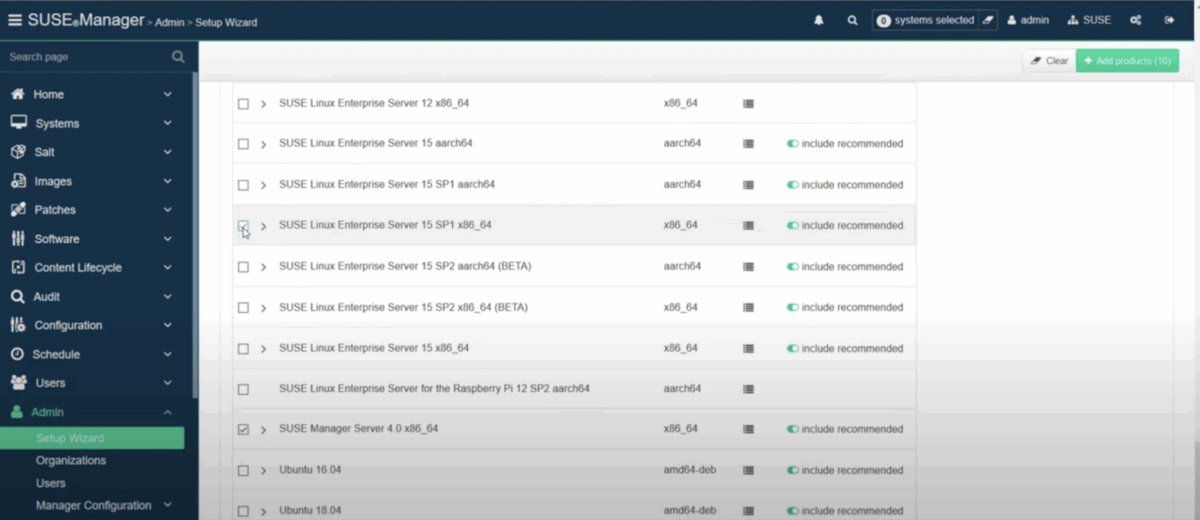
If you’re in a SUSE-centric environment, SUSE Linux Enterprise Server (SLES) supports KVM and Xen hypervisors, offering flexibility for Linux-heavy workloads. It includes built-in tools for VM lifecycle management, live migration, and high availability, all managed through YaST and SUSE Manager.
SLES also integrates with Rancher for container orchestration, making it a solid option for hybrid environments. As a VMware alternative, it’s ideal for enterprises standardized on SUSE looking to consolidate virtualization and container infrastructure under one support umbrella.
What You Get
- KVM/Xen support with virt-manager GUI.
- SR-IOV and Secure Boot for performance and security.
- Integration with Rancher for VM/container workflows.
Cost
Subscription-based, competitive with VMware for large deployments.
Pros
- Flexible KVM/Xen options.
- Enterprise-grade stability.
- Cost-effective for SUSE users.
- No per-core licensing.
Cons
- No polished centralized management.
- Smaller user base.
- Less optimized for Windows.
- Requires Linux expertise.
Example Use Case
If you’re a manufacturing firm running SAP HANA, SLES with KVM leverages your existing SUSE subscriptions for virtualization.
Best For
SUSE-based enterprises with Linux expertise.
How HorizonIQ Can Help
HorizonIQ can set up the necessary infrastructure for you to run SUSE Linux Enterprise. From here, your team would install SUSE Linux Enterprise and get it going.
10. Oracle VirtualBox
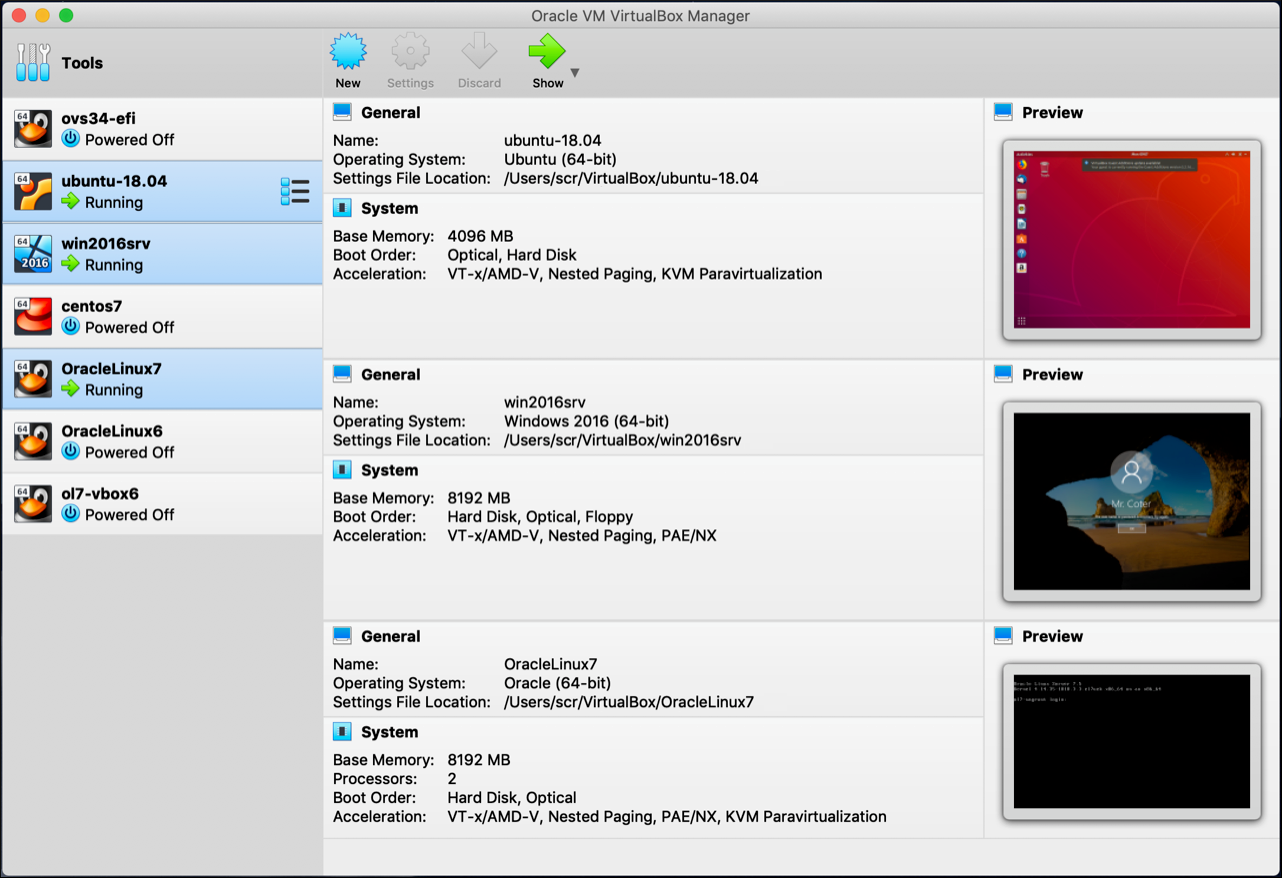
If you need simple, small-scale virtualization, VirtualBox is a free, Type-2 hypervisor for desktops and servers. It is also well-suited for non-production environments.
While it lacks enterprise features like clustering or live migration, it’s a reliable tool for testing, training, and local development. As a VMware alternative, it’s best for individual users or teams needing lightweight VM support without infrastructure overhead.
What You Get
- User-friendly GUI for VM creation.
- Snapshots, clones, and shared folders.
- Supports multiple OSes with paravirtualization.
Cost
Free, with an optional commercial Extension Pack for enterprises.
Pros
- Free and easy to use.
- Cross-platform versatility.
- Great for dev/test environments.
- No dedicated server needed.
Cons
- Not suited for production.
- Performance overhead is Type-2.
- Limited support and scalability.
Example Use Case
If you’re a software developer, VirtualBox lets you test applications across multiple OSs on your laptop to avoid VMware Workstation costs.
Best For
Developers, labs, and small-scale virtualization.
How HorizonIQ Can Help
HorizonIQ can set up the necessary infrastructure for you to run VirtualBox. From here, your team would install VirtualBox and get it going.
What Are the Best VMware Alternatives Based On Company Size?
Small Businesses
Select Proxmox VE for open-source flexibility and control, or Hyper-V in case you are a Windows shop. VirtualBox is suitable for small non-production environments like dev/test.
Mid-Sized Businesses
Consider Hyper-V on Windows servers, Proxmox VE for open-source clusters, or Nutanix AHV for simplified HCI management. XCP-ng is also a solid option to minimize licensing costs.
Large Enterprises
Employ a multi-hypervisor strategy. Utilize Nutanix AHV or Hyper-V for infra core workloads, OpenStack for scale-out private cloud, and Red Hat OpenShift Virtualization or SUSE Linux Enterprise for Linux-dominant workloads. Deploy XenServer in Citrix VDI environments where necessary.
Does Proxmox Meet Enterpise Needs as a VMware Alternative?
Proxmox is no longer just for home labs. What started as an open-source project has matured into a reliable, flexible, and production-grade hypervisor stack adopted by organizations of all sizes, from startups to nationwide retailers and engineering firms managing GPU workloads.
Enterprise users consistently report that Proxmox “just works.” Whether in 3-node clusters or sprawling 17-host, multi-site deployments with 400+ VMs and Ceph-backed storage, it handles high availability (HA), clustering, and live migrations with ease.
Some even refer to the stack as “self-healing” when paired with Ceph. Proxmox is also known for its resilience. One Reddit user noted the platform recovered completely from a failed Ceph node without any VM downtime.
Proxmox also integrates well with Veeam Backup solutions to enable enterprise-grade backup and disaster recovery strategies. Administrators can leverage Veeam’s backup scheduling, instant recovery, and replication features to protect Proxmox virtual machines while gaining data integrity and minimizing downtime even during critical failures.
Cost Savings Without Compromising Functionality
Proxmox eliminates hypervisor licensing costs while offering features comparable to vSphere, including. One enterprise cited a $2.3 million VMware licensing quote they avoided by switching.
Storage & Backup Options That Work
Proxmox integrates well with enterprise storage options like Starwind VSAN, Ceph, iSCSI, and NFS. Users run clusters on shared NetApp storage and Cisco UCS blades without issue. Meanwhile, Proxmox Backup Server offers high deduplication, easy offsite sync (even to S3 or AWS), and native VM and container backups (often cited as “zero-budget” DR for small teams).
Performance & Flexibility
Compared to ESXi, many users find Proxmox faster and more resource-efficient. Linux-native tools, live migration, and RESTful APIs support automation with Ansible and Terraform. Though it lacks a polished vSphere/vCenter equivalent, many are scripting and automating day-to-day tasks to reduce tech debt and maintenance overhead.
What Are the Next Steps When Choosing a VMware Alternative?
The virtualization landscape in 2025 gives you plenty of options to move away from VMware, while balancing cost, simplicity, and your strategic goals.
Open-source picks like Proxmox and XCP-ng cut licensing fees, Hyper-V leverages your Microsoft ecosystem, Nutanix AHV simplifies HCI, and cloud VDI like Ace Cloud supports remote work. Here’s how to get started:
- Inventory Your Workloads: List your current workloads and pain points with VMware.
- Test Alternatives: Try a free trial of Proxmox or Hyper-V on non-critical systems to see what fits.
- Assess Training and Support: Check what skills your team needs and what vendor support is available.
- Plan a Phased Migration: Move gradually to minimize risk.
If you’re weighing multiple options, I recommend engaging with user communities like Reddit, running trials, and measuring performance to find your best fit. You can also partner with a neutral managed infrastructure provider, like HorizonIQ, that can help you pilot and compare setups without committing upfront.
By diversifying your virtualization strategy, you’ll cut costs, boost flexibility, and future-proof your IT infrastructure with modern VMware alternatives.




